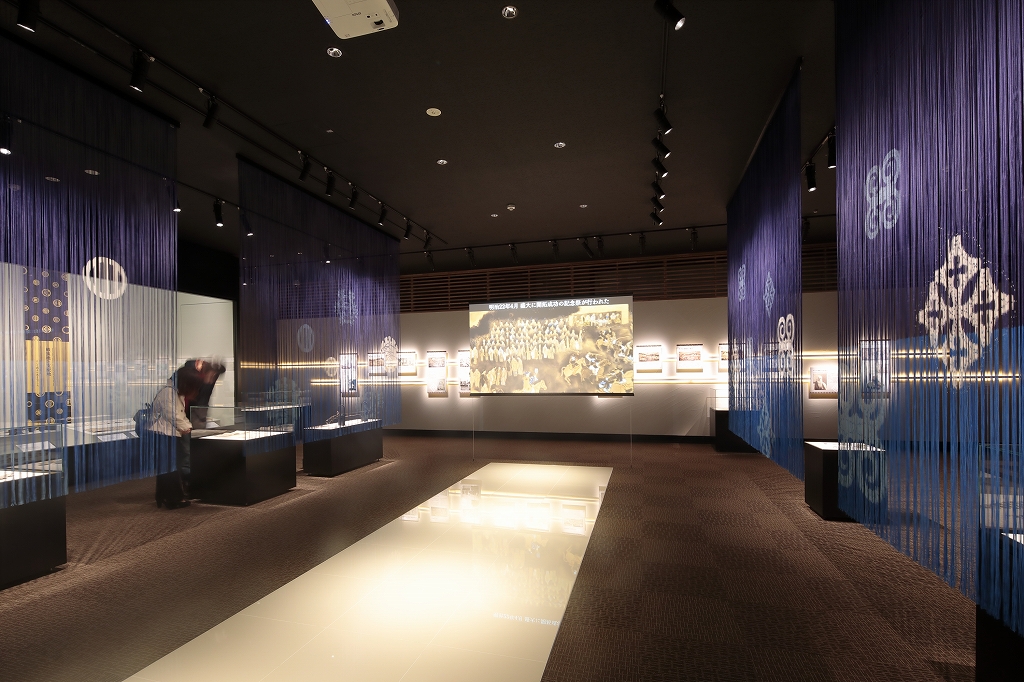
 | FEATURE ARTICLES | The history of the land and the town plaza
| FEATURE ARTICLES | The history of the land and the town plaza 
The first floor of the Date City Museum of History and Culture, comprised of a large glass window and a white theme interior looks like a café or gallery.

The learning studio on the first floor
The stairs going up to the exhibition room on the second floor open into a space of history. Cultures from the Jomon Period and Ainu are exhibited on the right side of the center passageway, and items related to the Watari-Date clan, who settled in the Meiji period are exhibited on the left. The zones are placed face to face without partitions and with no set route. Visitors can see the exhibitions from either zone or view both zones at the same time. In the center of the room, there is a screen showing a scene of a meeting between the Ainu and Watari-Date clan in front. In addition, the two zones are connected by the screen and a panel exhibition called “The walking together road” on the far side.
Motoshige Date, the curator, explains that the goal of the exhibition is to allow visitors to experience contact with other cultures.
“When talking about Date town, we tend to see it from viewpoint of history and the samurai culture of the Watari-Date clan as settlers to the area. Although the Ainu culture still continued after the arrival of the settlers, the viewpoint of the Ainu culture was missing. So, we created a three dimensional exhibition to understand that today’s Date was born from the contact of two cultures.

Treasures of the Watari-Date clan are exhibited in the Watari-Date clan passage

Motoshige Date, curator of the Date City Museum of History and Culture, is the 20th family head of Watari-Date clan
The museum has concierges, about 40 people mainly from Date City, who are volunteer exhibition guides. The Museum Concierge was established as a public and private organization. It share the attractiveness of the history and culture of Date with residents and is involved in community development not only by supporting exhibition guides but by proactively introducing other cultural facilities, planning events, and developing museum goods.
Vice-President Asami Hoshi, who moved from Sapporo to Date because she was interested in the history and culture of Date, established a company for community development.

Ms. Hoshi Asami is proud that Date is an attractive town.
“Date has many tourism content which are unique,” says Ms. Hoshi. Tourism has value, not in looking for gourmet cuisine and souvenirs, but as places which provide deep knowledge. “The unique history and culture can be used for corporate training programs, etc. People gather and interact with one another in the town when they are connected, not only by general tourism but also by business. If the museum becomes a hub, concierges can improve their skills and activities, leading to economic activities.”
Ms. Hoshi’s idea was born from her experience as a coordinator who organized international conferences. “The content will be very attractive to people with intense intellectual curiosity. I think community development promoted by history and culture based on the museum is necessary for people notice its value and recognize it as an industry,” Ms. Hoshi explains from her experience.

Original museum goods
The world of Jomon of 6,000 years ago has been reconstructed at Kitakogane Kaizuka Park, which symbolizes the history and culture of Date.

Kitakogane Kaizuka Park
“Kitakogane Shell Midden is thought to have been a standard Jomon village. This site allows us to experience the connection between the present living and the land of 6,000 years ago. Contact with the Jomon culture overlaps with the concept of the museum, namely the contact with other cultures. We can more fully understand Date’s land by learning about Jomon here and about periods after that with the help of the museum,” remarks Yukihito Nagaya, curator of the Date City Institute of Funkawan Culture.

Nagaya Yukihito
Maybe the Date City Museum of History and Culture is not the name of the building but that of the plaza where the remaining resources of history and culture of Date town gently connect to each other.
Date City Museum of History and Culture 

Umemoto-cho 57-1 Date City, Hokkaido, Japan
Tel.: 0142-25-1056
Hours: 9:00 to 17:00
Closed:Monday , from December 31st to January 5th
Admission fee: Adult 300 yen, Elementary, Junior High, and High school students 200 yen
*Admission to the first floor is free
Kitakogane Kaizuka Park 

Kitakogane-cho 75, Date City, Hokkaido, Japan
Tel.: 0142-24-2122
Hours: 9:00 to 17:00
Period:From April 1st to November 30th
Admission fee:free
Website